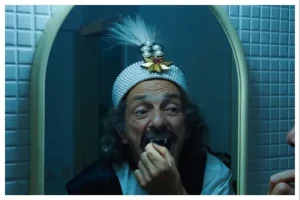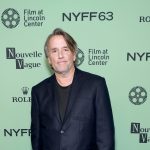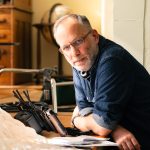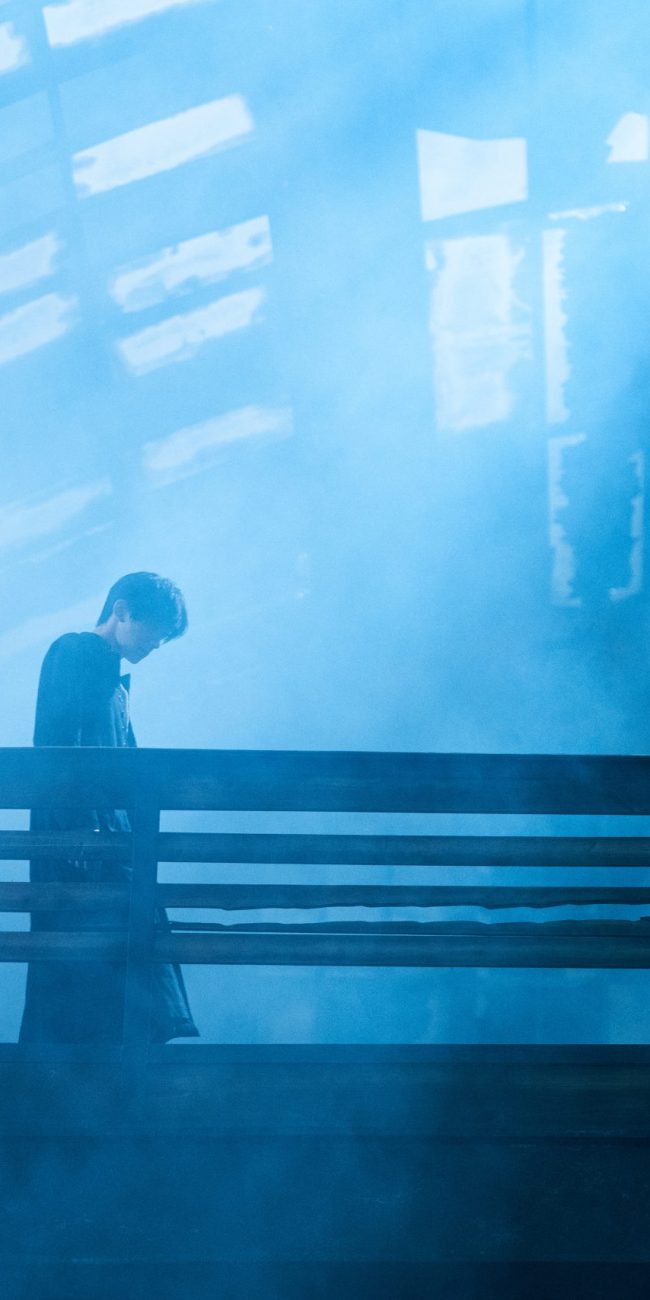A Conversation with Radu Jude (DRACULA)

Romanian filmmaker Radu Jude has built a reputation for making films confronting history, technology, and national mythology. His latest film, Dracula, is perhaps his most audacious provocation yet: a 170-minute, 14-segment epic that weaponizes artificial intelligence, iPhone footage, and absurdity to interrogate what happens when a culture feeds endlessly on its own past.
A frustrated director turns to an AI chatbot to salvage his vampire movie after disappointing test screenings. What follows is a journey through Dracula mythology: from union-busting corporate vampires to Transylvanian tourist traps, from AI-generated orgies to a surprisingly tender adaptation of an obscure Romanian romance novel. Twenty actors cycle through over 100 roles across visual styles that range from classical cinema to deliberately glitchy.
If Jude’s previous work, including Bad Luck Banging or Loony Porn (which won the Golden Bear at Berlinale) and Do Not Expect Too Much from the End of the World, have established him as a filmmaker unafraid to mix dick jokes with philosophy, and to make films that are as confrontational as they are formally inventive. Dracula pushes this approach further, using the vampire myth to explore how history, technology, and capital all function as parasites, feeding without permission, recycling without shame.
Shot on an iPhone, Dracula is gleefully vulgar, and aware of its own ridiculousness. It’s a film about how AI is just another vampire in a world already full of them, however, It argues that AI is only as gross as the society it imitates. I spoke with Jude about his collaboration with amateur AI user Vlaicu Golcea, the freedom of digressive storytelling, and why he deliberately chose the most disturbing, most obviously broken AI imagery for his film in the following conversation edited for length and clarity. Seeing the film in theaters at the New York Film festival is a movie going experience I will always remember.
Hammer to Nail: It’s good to speak with you again. We spoke for Do Not Expect Too Much From The End of the World, another movie that I love very much. I’m very excited to get into it again with you for this movie, which I got to see two times, once in theaters and then once at home. You worked with Vlaicu Golcea on the AI sequences. So I’m wondering what that collaboration was like? And in particular, I’d love to discuss the Hollywood section of the film, which is an extremely funny and disturbing moment.
Radu Jude: Vlaicu is a composer, a jazz musician, a cello player. But in the last few years, he stopped doing that and he’s been doing an internet radio theater. When I heard from someone that he’s into AI images, as an amateur, but as a passionate amateur, I went to visit him and he showed me what he does. I said, okay, let’s work together for this film. He said, “But you know, I’m just using them as an amateur.” I said, “Well, I don’t need more than that.”
I basically broke up the script that we had into which sequences we can do with AI, which ones we cannot do, and we started trying and sketching things out. We discovered that some were impossible to do, so I either erased them or changed them and shot them or whatever. I didn’t want the whole thing to be AI. I just wanted to have it here and there, first of all for production and budgetary reasons, for aesthetic reasons, and then for my curiosity of exploration of this new tool. If it is a critique or not, I think it can be seen as a critique in the end, but it’s a critique which is mixed with some real curiosity about this new tool or about this new medium.

A still from Radu Jude’s DRACULA
How we worked depended on the sequence. I made a classical shot list like, “full shot where this happens, then a medium shot, this happens…” He started to test on several AI generators. Some did better things, some less. But that’s the definition of creativity, to find ways to mix. He could generate an image in Midjourney, I would choose one from several, then he would animate that in another software. It was four second clips, which was the limit at the time, now it’s gone. We would take these four seconds, put it in another kind of software that would alter that and generate something else but longer. So it was like that, back and forth in a very amateurish way in the end. Sometimes we started from reference images and the software would generate around that. Sometimes we would start from text prompts. It was always a mix of things.
For the Hollywood section, first of all, the film has a lot of references to other works of art or to other things that engage with the Dracula myth. There’s, of course, references to literature, Murnau’s Nosferatu, Francis Ford Coppola’s Bram Stoker’s Dracula, etc. Which is actually a great film. It’s a film I liked a lot and as a director, I respect a lot.
When we saw this film, I saw it first when it was released, it was one of the few films after the revolution that came straight to cinemas in Romania. At the time, I think it was 1992. We saw it in the cinema. For us kids in Romania, the funniest thing was that at some point, there’s some dialogue in Romanian. This dialogue is in pretty broken Romanian. It’s obvious, I think they didn’t pay much attention to that. The actors just learned it a little bit. There was not a lot of attention to how it was done because, of course, it’s for Romania. I mean, who would care about that? Only some Romanians, and they don’t count that as the main audience, of course, so I can understand why it was broken Romanian.
But for us it was a bit off-putting. We were always quoting that because they spoke in a crazy way. That was a kind of running joke in our teens for years. This phrase from Coppola’s Dracula.
When I wanted to make a kind of homage to and reference to Coppola’s Dracula, I of course remembered this scene and I said, okay, let’s recreate that, or make an intervention into that. Of course, that would be impossible without a great amount of money to buy rights from a Hollywood movie. So in the end, I thought let’s remake it in a different way with the AI, and only keep the lines. We started to do that because in the film, there’s Winona Ryder and Gary Oldman. They fly through a restaurant. He’s taking her in his arms and they fly away. It’s a hot and erotic moment.
So we said, okay, let’s push that moment now further and make it pornographic somehow, but digital. But then we discovered that these programs don’t really make porn images. Vlaicu found a kind of shortcut through forums and how you can somehow generate fixed images which could include naked people and imitate sexual imagery. But the result was always really, really not good. I mean, the sexual organs were in different positions, so he tried hundreds of images like that. He said, “I give up!” I said, “Show it to me.” We watched them and I said, “Oh, but they are so funny. They’re great.” So I made a montage only with those, and we put the sounds over it. That’s how we did it.
HTN: Yeah, those sounds really come together with the images in quite a way. That’s a great moment. You shot most of this on an iPhone due to budget constraints, but also curiosity on your part. So did that limitation lead to creative discoveries that you wouldn’t have made with a traditional setup? You worked with Marius Panduru on this film. Could you discuss what that collaboration looks like?

A still from Radu Jude’s DRACULA
RJ: Marius is a very experienced cinematographer. We’ve worked together since forever. He works a lot with all kinds of media and films, he did TV movies, he did music videos, hundreds of music videos in the late ’90s and early 2000s, he did commercials, he did big movies like the one with Juliette Binoche and Ralph Fiennes. From a technical point of view—he knows everything: lenses, cameras, physics of images, chemistry, film stocks, everything.
In the last ten years, he’s become more adaptable. It was a time when he was rejecting things like that. He said, “That’s not serious. Let’s do it on 35 MM.” But now we grew old and we are more open to things. So when I said, “Marius, we have a problem with budget, let’s try to make the film on iPhones or small digital cameras,” we tested a lot of cameras and iPhones. We did one day of tests. In the end, we saw it’s quite good. The quality for what you want is quite good. Of course, we need to adapt to the tool.
Maybe force the tool because we shot also with no light, he gave up all the additional lights. So we shot everything, even night scenes in a city which is not very well lit, with this iPhone. Sometimes the image is not working very well. But I think that’s part of the aesthetics and not only of the economy, but it starts from the economy in a certain way. I always consider that to be creative in cinema means not only to have an ideal film and make it, which could be great, and sometimes it’s great, but there’s another type of creativity. I think someone like Orson Welles was a master of that, which means to adapt to what you have and what you can do with what you have. So this was our thinking.
What you discover, it’s difficult to put into words. If you get used to a certain tool, you can discover the beauty of it in a certain way. Because the first days I felt, oh, it looks so ugly, you know, and then you say, “oh, it’s quite interesting.” You start having a certain affection for this kind of image. The flexibility of shooting and the fact that you can shoot things in a street crowded with people and nobody pays attention to you. You’re just like a tourist with an iPhone.
HTN: The Homecoming section I really loved. The screenwriter requests something tender about Vlad returning home. We’re told very bluntly the grotesque origins of Vlad the Impaler. While this is happening, the real Vlad is there proudly exclaiming that everything is 100 percent true. After continually interrupting the show, she’s thrown out by a security guard with a Hitler mustache. Then we cut to our screenwriter who is very approving of what the AI has come up with for the sequence. So what was important to you in crafting this moment?
RJ: I think it’s a film which uses a kind of literary device of literature with digressions. At the same time, one of the experiences when I use this fake AI character, which is myself generating stories, I think one of the joys with working with AI in general, and one of the experiences that you have, is that you ask something and you receive something quite different. That creates a kind of thing where you say, “Okay, no, this is not what I wanted.” You have that with ChatGPT, you can have it with other AI tools. It’s always something which is not perfectly done or offered.
So I wanted to use this kind of freedom. That gives you a freedom because you can, in a way, allow yourself to do whatever you want and to offer to the audience whatever you want. Of course, it’s not exactly what people expect and not exactly what even the character of the narrator asked for. But that’s the joy of seeing that you don’t get what you ask for, you get something else. I felt very happy doing this film using this structure.

HTN: Yeah, it was a great structure. Those scenes with the screenwriter were so funny. Section number five is a switch in register, as we find you in a somewhat more classical mode of filmmaking. I want to discuss this climax where the man reveals he has a wife. The zoom into his face with that hilarious smile and then cutting to her in shock was so great. She jumps out of the car and we’re served some AI slop as we cut to the man getting out of the car to find her impaled. This section also ends with him driving furiously as he screams and we get another helping of deeply confusing AI imagery. Our screenwriter once again approved. So what was your thinking here in crafting this moment?
RJ: This is an adaptation of a very weird, really obscure Romanian short story “Just So” by a forgotten writer. His name was Nicolae Velea. I heard about this story because I had a very old friend who passed away two years ago, and at some point he mentioned this writer to me, so I read him. When I started to generate the stories for this film, I said, okay, maybe it would be interesting to offer something which is not in the line of the others. It’s like, you know, you go to a restaurant and they say, you can have a steak, you can have this, you can have that. But for vegetarians, we can give them a salad, and for kids, we give them a schnitzel or whatever.
So it was the idea to offer something for everybody in the film. But in a way, it’s striking because there’s some similar things about the nature of evil. The woman is actually impaled with a stick in her chest, which connects it in a very undercurrent way to the main story of Dracula. It’s a bit like on a whim, because, of course, some people complain and they say, you know, “This story doesn’t have any connection.” So it means, could you as an author put everything you want in a film even if its not necessarily connected? And my answer is yes, more and more.
Actually, there is, I don’t know if you know this, a quite well-known Polish novel from the 1930s called Ferdydurke by Witold Gombrowicz. Susan Sontag wrote a great foreword on this, I think the first edition in the ’60s in the US. Gombrowicz at some point in the book, which is a novel, stops the novel and says, “And now I’m going to offer you a short story that doesn’t have any connection with the novel.” He said, “I tested that with some friends and they said, ‘You cannot put a short story that doesn’t have any connection with the novel in the novel.’ And he said, ‘Well, I will show you, I can put it.'” And it’s there. It’s two short stories, actually, one in the first third and the other in the second third of the book. So I said, well, why not follow this example and put something that doesn’t have a real connection. So there are two stories like that in the film.
HTN: Well, Radu, thank you so much. It was really so great to get to speak with you again. I thought the film was so amazing. I’m looking forward to checking out Kontinental ’25 and hopefully we can speak again on that one.
RJ: Oh, yeah, I would love to.
– Jack Schenker (@YUNGOCUPOTIS)











